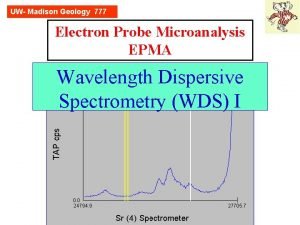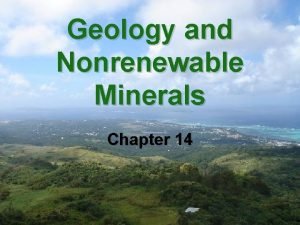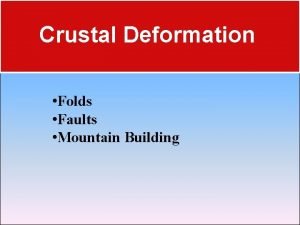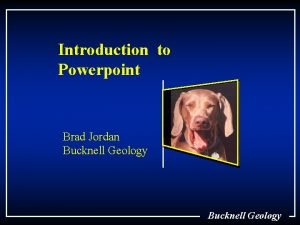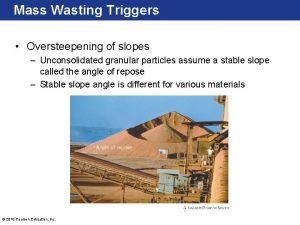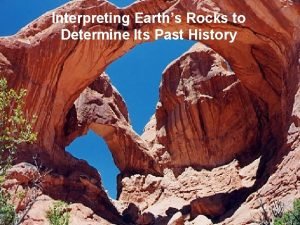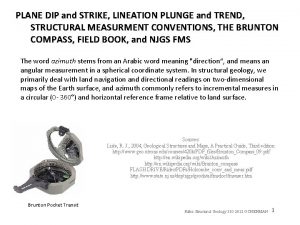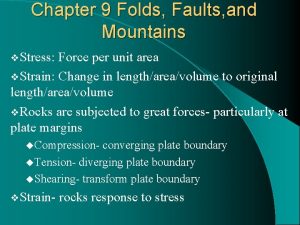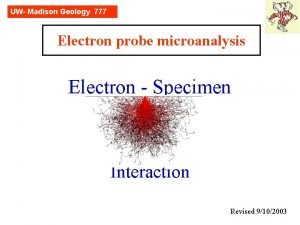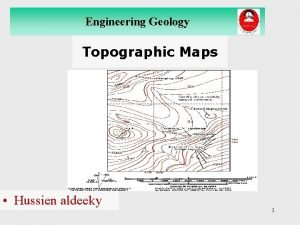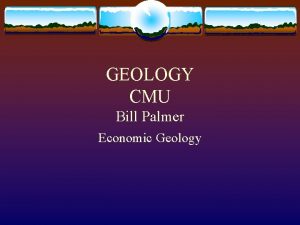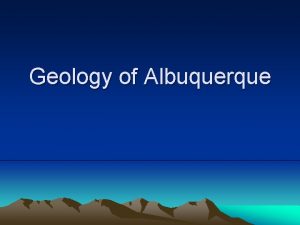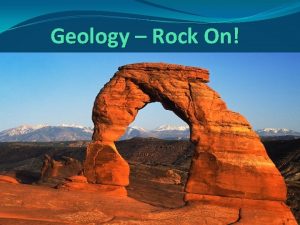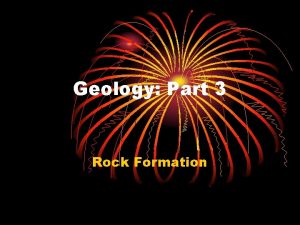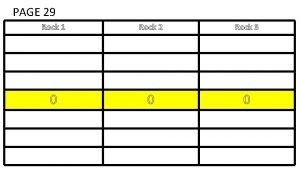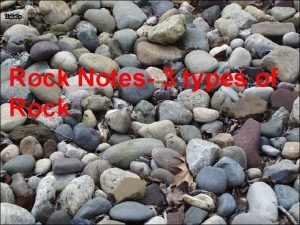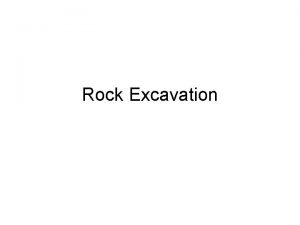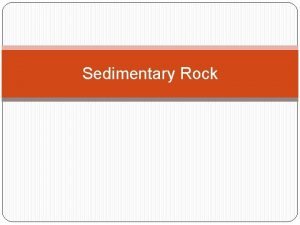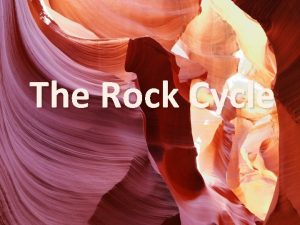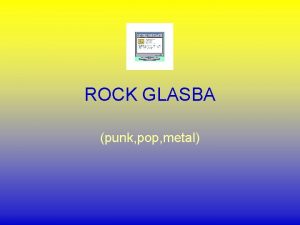Geology Rock On What is a Rock A























- Slides: 23

Geology – Rock On!

What is a Rock? �A naturally occurring solid combination (aggregate) of one or more minerals. � 3 Types of rocks: �Igneous �Sedimentary �Metamorphic.

Minerals �Occurs in nature inorganically with specific chemical properties and a definite structure. �There are over 4, 900 known mineral species. �Minerals are distinguished by physical and chemical properties. �Minerals have color, luster, streak, hardness, cleavage, fracture and specific gravity (density).

Mineral Shapes:

Gems � Gems are visually attractive and rare minerals. The brighter the gem the more desirable it is. � A gem is precious or semi-precious and if cut and polished can be used for jewelry. � The 4 precious gems: diamond, ruby, sapphire, emerald. � Semi-precious gems: amethyst, amber (organic), pearls (from sea creatures), garnet, aquamarine, topaz, peridot, garnet, topaz, turquoise, etc. � Most birthstones are gems: diamond, amethyst, sapphire, ruby, etc. � $$$$$$$$$$$$$


Three Types of Rocks: �Igneous: �Crystallization of magma or lava. �Latin for “fire”. �Sedimentary: �Formed at or near the earth’s surface by an accumulation of particles (small or big). �Latin for “settling”. �Metamorphic: �Result of igneous, sedimentary or metamorphic rocks “changing” from high heat and pressure. �Greek for “change form”.

Igneous �Intrusive/plutonic – formed under the earth’s surface. �Course grained, cools slowly, hard, crystal texture, no banding or layering �Extrusive – formed above the earth’s surface. �Fine grained or smooth, cools quickly, no banding or layering. �Felsic – usually light in color and has high silica content with quartz. �Mafic – usually dark in color and has low silica content, high in iron and magnesium. �The heat from the earth comes from gravity and pressure deep underground, and also mostly from radioactive decay.


Sedimentary �As particles settle, pressure causes the material to become compacted or cemented. �Clastic/Detrital – formed from an accumulation of fragments of pre-existing rocks and minerals. (conglomerates, sandstone). �Organic – formed from the action of plant and animal remains (mud rocks, coal, limestone from shells, corals). �Chemical – non-clastic, from a saltwater or water solution that is concentrated and what is left after the liquid evaporates (fine grained limestone).

Origin of rocks �Sedimentary rocks are formed from other rocks that are broken into small particles and moved by erosion (wind or water) �The particles are squeezed or cemented together �Rocks are layered www. energyinst. org. uk/education/glossary/


Metamorphic �The most complex group of rocks. �Through heat, pressure, and chemical processes deep underground, the mineralogy, texture and chemical composition of the rock changes. �Foliated – has layering or banding �Schist has layering, ancient Greek “split”, schistose fabric, has schistosity, fissile (splitting in thin layers), mica or horneblende are aligned and elongated > 50% makeup. � Gneiss (pronounced nice) has banding, mica or horneblende are aligned and elongated < 50% makeup. �Non-foliated – no layering or banding (marble, quartzite).


Schist is formed by regional metamorphism and has schistose fabric�it has coarse mineral grains and is fissile, splitting in thin layers. (more below) Schist is a metamorphic rock that comes in almost infinite variety, but its main characteristic is hinted at in its name: schist comes from the ancient Greek for "split, " through Latin and French. Schist is a rock formed by dynamic metamorphism at high temperatures and high pressures that aligns the grains of mica, hornblende and other flat or elongated minerals into thin layers, or foliation. At least 50 percent of the mineral grains in schist are aligned this way (less than 50 percent makes it gneiss). The rock may or may not be actually deformed in the direction of the foliation, although a strong foliation probably is a sign of high strain. Schists are commonly described in terms of their predominant minerals. This specimen from Manhattan, for example, would be called a mica schist because the flat, shiny grains of mica are so abundant. Other possibilities include blueschist (glaucophane schist) or amphibole schist. http: //geology. about. com/od/rocks/ig/metrockindex/rocpicschist. htm#stepheading

Gneiss ("nice") is a rock of great variety with large mineral grains arranged in wide bands. It means a type of rock texture, not a composition. (more below) Gneiss is a typical rock type formed by regional metamorphism, in which a sedimentary or igneous rock has been deeply buried and subjected to high temperatures and pressures. Nearly all traces of the original structures (including fossils) and fabric (such as layering and ripple marks) are wiped out as the minerals migrate and recrystallize. The streaks contain minerals, like hornblende, that don't occur in sedimentary rocks. In gneiss, less than 50 percent of the minerals are aligned in thin, foliated layers. You can see that unlike schist, which is more strongly aligned, gneiss doesn't fracture along the planes of the mineral streaks. And thicker veins of largegrained minerals form in it, unlike the more evenly layered appearance of schist. With still more metamorphism, gneisses can turn to migmatite and then totally recrystallize into granite. http: //geology. about. com/od/rocks/ig/metrockindex/rocpicgneiss. htm#stepheading

The Rock Cycle



Links that Rock! �http: //geology. com/rocks/ �http: //geology. about. com/od/rocks/a/Rock. Tables. htm �And for some GREAT bumper stickers……. � Sources: geology. com, wikipedia, Prentice Hall Science Book, Mariam-Webster.



Rocks to know: Igneous Rocks: Granite, Basalt, Pumice, Obsidian, Scoria. Know which are: intrusive/plutonic or extrusive, coarse or fine grained, cooled slowly and quickly. Sedimentary Rocks: Conglomerate, Limestone both organic and chemical, Bituminous Coal, Shale, Sandstone. Know which are clastic, organic, or chemical. Metamorphic Rocks: Gneiss, Muscovite Schist, Anthracite Coal, Marble, Slate. Know which are foliated and non-foliated.
 Metamorphic rocks
Metamorphic rocks A rock climber's shoe loosens a rock and her climbing buddy
A rock climber's shoe loosens a rock and her climbing buddy Rock cycle sedimentary
Rock cycle sedimentary A rock climber's shoe loosens a rock and her climbing buddy
A rock climber's shoe loosens a rock and her climbing buddy Igneous rocks metamorphic rocks and sedimentary rocks
Igneous rocks metamorphic rocks and sedimentary rocks How do rocks form
How do rocks form Rock climb
Rock climb Eduqas geology
Eduqas geology Conformable contact geology
Conformable contact geology Structural geology
Structural geology Define physical geology
Define physical geology Geology
Geology Geology
Geology Geology
Geology Evento
Evento Introduction to geology ppt
Introduction to geology ppt Oversteepened
Oversteepened Gcse geology
Gcse geology Angular unconformities
Angular unconformities Geology
Geology How to measure trend and plunge with a brunton compass
How to measure trend and plunge with a brunton compass Oil accumulation
Oil accumulation Uw
Uw Aldeeky
Aldeeky












